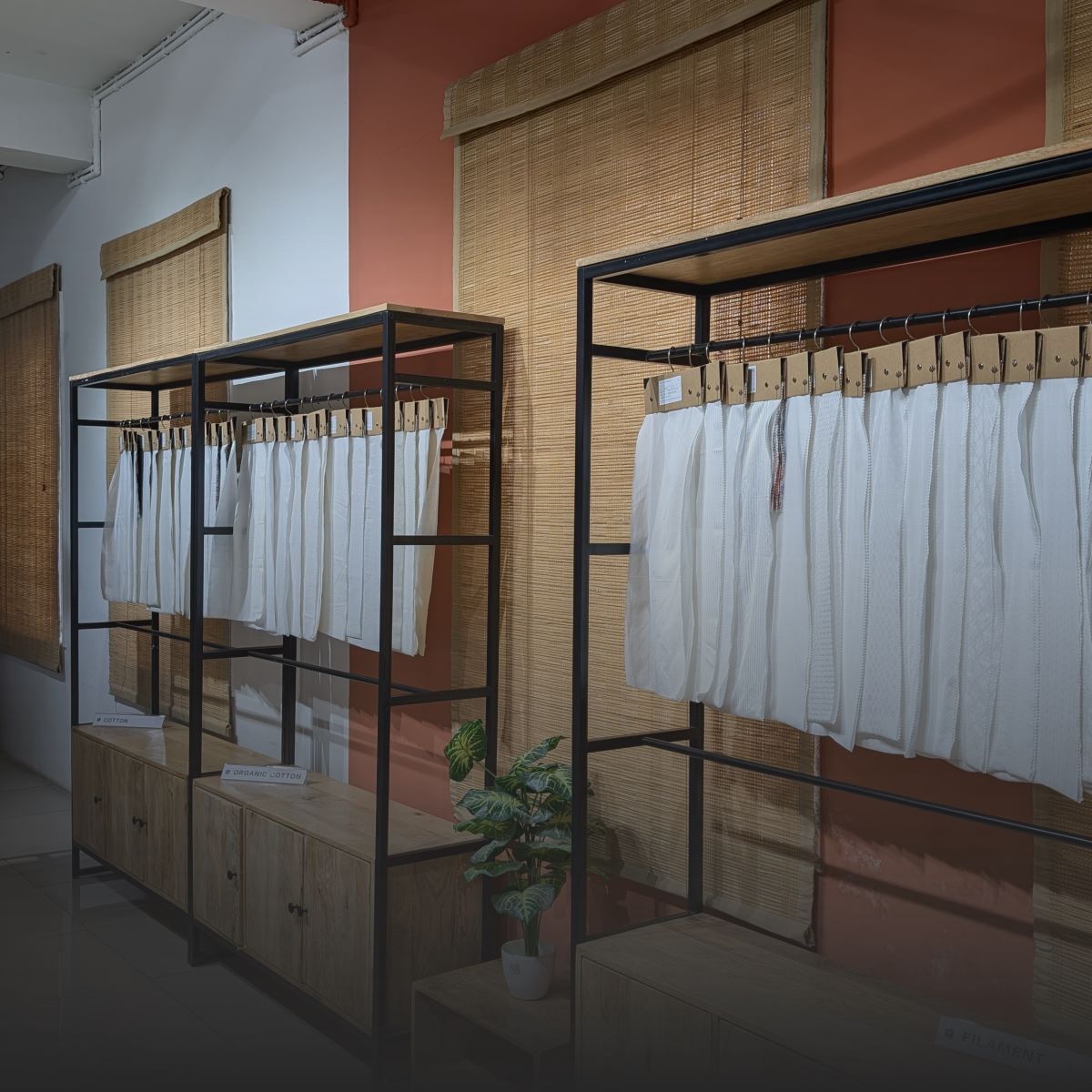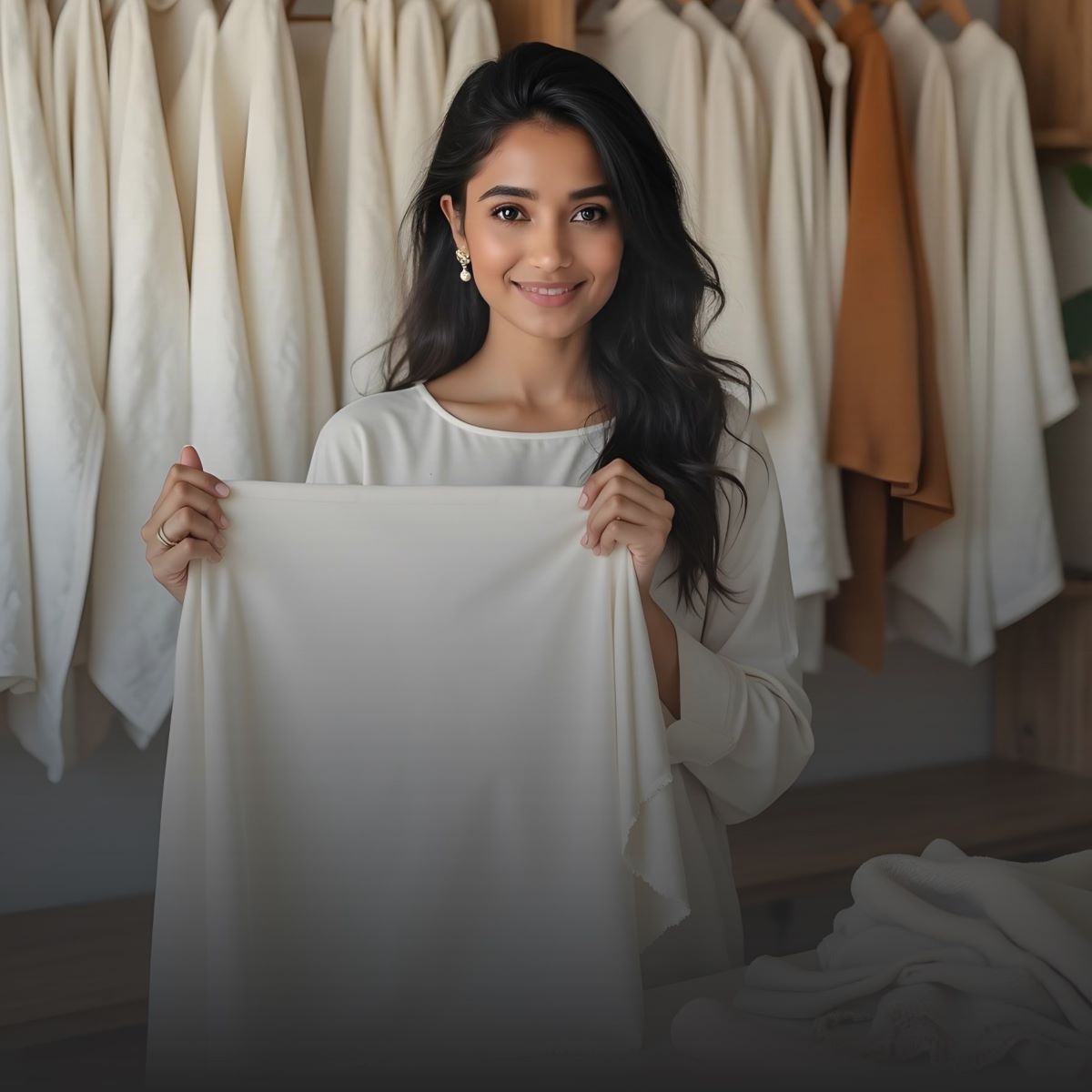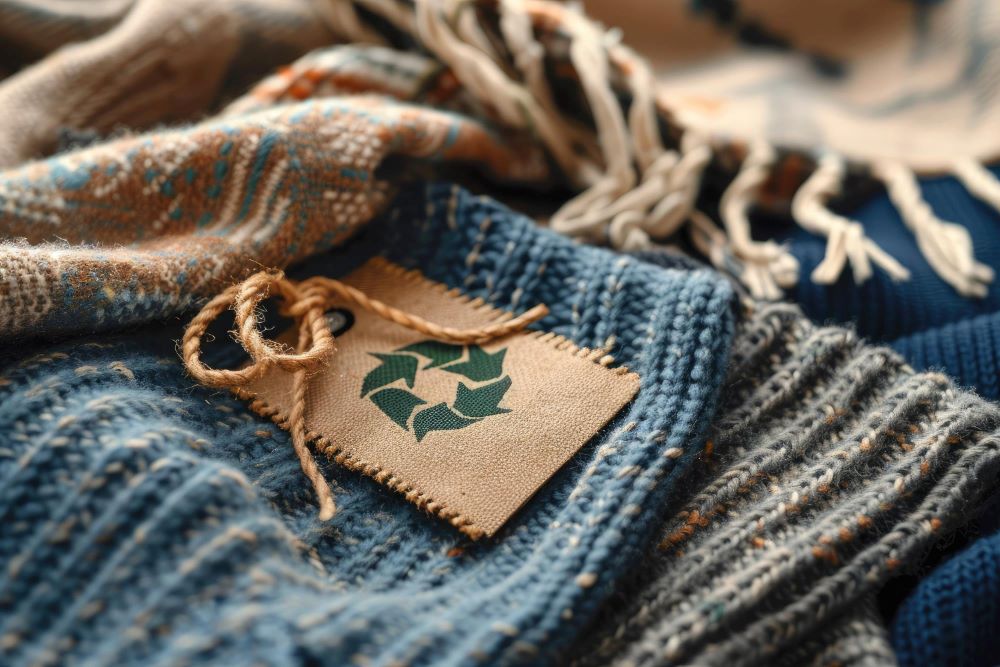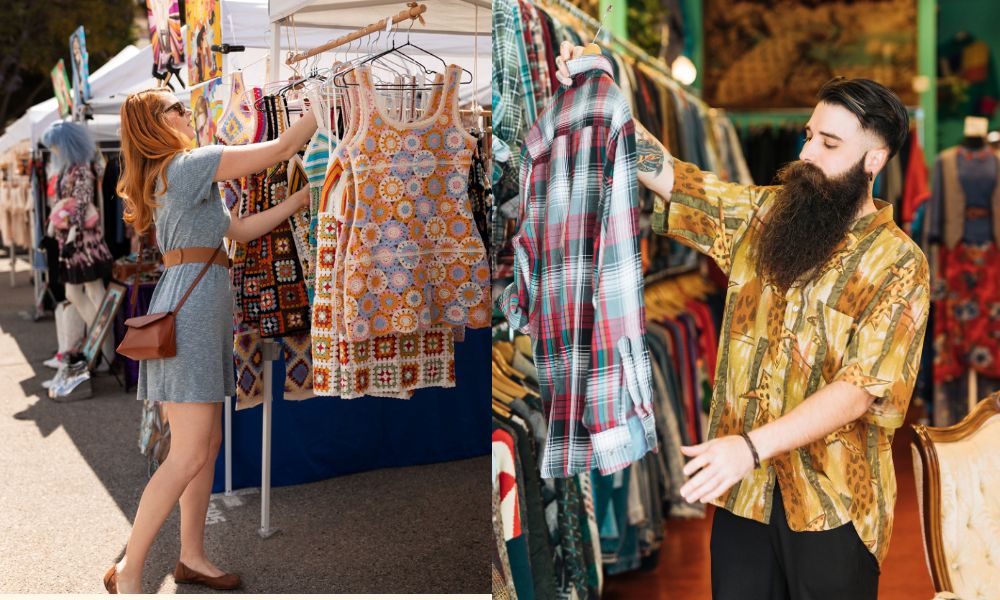Fashion is at a turning point. Sustainability is no longer a trend; it is a basic expectation.
With rising awareness about climate change, water scarcity and ethical sourcing, fashion designers and brands are facing a critical decision: stick to outdated materials or shift to fabrics that are better for people and the planet.
The truth is hard to ignore. The fashion industry is responsible for 20% of global water waste and contributes to 10% of global carbon emissions. On top of that, 85% of textiles end up in landfills. As demand for clothing grows, so does the environmental cost.
This is where fabric choices matter. Designers are in a powerful position to lead change, starting with the materials they choose. Luckily, sustainable fabrics are no longer hard to find or limited in style.
In this blog, we will explore the top sustainable fabrics that every designer should know in 2025. Whether you are creating everyday basics or luxury collections, this guide will help you source responsibly, reduce your impact and design with confidence.
Also Read For More Related Information: Sustainable Fabrics Meeting International Eco-friendly Standards
Why Sustainable Fabrics Matter in 2025
We only have one home—our planet. And right now, fashion is one of the biggest reasons it's under pressure.
Most people do not realize it, but the clothes we wear come at a huge cost. Fashion is the second-largest consumer of water globally. Producing a single cotton shirt uses up around 2,700 liters of water, the same amount one person drinks over two and a half years. Cotton farming alone uses nearly a quarter of all insecticides and 11 percent of all pesticides on just 3 percent of the world’s farmland.
Add to that the 21 billion tons of textile waste that go into landfills every year and it becomes clear: the way we make and consume clothes needs to change.
This is not about guilt. It is about responsibility. If you are a designer, brand or manufacturer, your fabric choices directly shape that future. The good news? Sustainable fabrics are no longer a niche idea—they are a necessity.
2025 is not the time to "consider" eco-friendly fabrics. It is time to make them the default. Because the demand is rising, the planet is at risk and the industry is ready for better solutions.
The question is not if we should switch to sustainable fabrics. The question is—what is stopping us?
Also Read: How U.S. Designers Are Using Sustainable Fabrics to Set Trends
Top Sustainable Fabrics Every Designer Should Know

These top sustainable fabrics are perfect for modern, eco-friendly clothing. From organic cotton and hemp to TENCEL™ and banana fiber, each fabric offers a cleaner alternative to traditional textiles. They're great for everything from basics to high-end fashion—without harming the environment.
Organic Cotton

Overview:
Organic cotton is cultivated without synthetic pesticides, fertilizers or genetically modified seeds. It is one of the most familiar and widely accepted eco-friendly alternatives in fashion.
Why It’s Sustainable:
Organic cotton farming consumes significantly less water and helps maintain soil health. It protects farmers from chemical exposure and reduces environmental runoff. In 2020/21, organic cotton accounted for approximately 1.4% of global cotton production, with a 37% growth in organic fiber output from the previous year. This upward trend highlights a growing shift toward cleaner cotton farming practices.
Best Use Cases:
Comfortable and breathable, organic cotton is ideal for everyday basics, loungewear, kidswear and even formal wear, depending on the weave.
Hemp

Overview:
Hemp is one of the oldest and most sustainable natural fibers used in textiles. It is known for being strong, breathable and resistant to wear and wrinkles.
Why It’s Sustainable:
Hemp grows quickly without the need for synthetic fertilizers or excessive water. It restores soil health and absorbs more carbon dioxide than many other crops. Its environmental footprint is minimal compared to conventional fibers.
The hemp fabric market is growing fast. It was worth about USD 16.94 billion in 2024 and is expected to reach USD 159.70 billion by 2032. That’s a big jump, showing that more people around the world want eco-friendly fabrics like hemp.
Best Use Cases:
Due to its strength and structure, hemp is widely used in jackets, denim, bags, casual wear and heavy-duty garments like workwear and uniforms. Its natural texture also fits into modern "earth-tone" aesthetics.
TENCEL™ (Lyocell / Modal)

Overview:
TENCEL™ fibers are derived from sustainably harvested wood pulp and made using closed-loop processes that reuse water and solvents.
Why It’s Sustainable:
It uses 50% less water and emits less carbon than conventional rayon or cotton. Produced by Lenzing, TENCEL™ is biodegradable and certified safe for skin.
Best Use Cases:
Soft essentials like athleisure, dresses, undergarments and resort wear. Its silky finish and drape make it a designer favorite for elevated basics.
Recycled Polyester (rPET)

Overview:
rPET is made from post-consumer plastic bottles or old polyester garments, reducing reliance on virgin petroleum.
Why It’s Sustainable:
It diverts plastic waste from oceans and landfills. By 2023, 13% of all polyester globally came from recycled sources, up from 8% in 2008. It uses less energy to produce compared to new polyester and supports circular fashion.
Best Use Cases:
Activewear, jackets, bags, swimwear and durable outerwear.
Piñatex (Pineapple Leather)
Overview:
Piñatex is a leather alternative made from waste pineapple leaves—byproducts of existing agriculture.
Why It’s Sustainable:
No extra water, pesticides or land is needed. About 480 pineapple leaves make one square meter of Piñatex. It contains 80% pineapple leaf fiber and 20% bioplastic (PLA). Even the leftover pulp is used as fertilizer, creating a near-zero-waste process.
Best Use Cases:
Vegan footwear, handbags, belts and accessories. It offers a leather-like texture with a much smaller footprint.
Banana Fiber
Overview:
Banana fiber is extracted from the stems of banana plants after fruit harvest, offering a strong yet flexible textile.
Why It’s Sustainable:
It utilizes agricultural waste that would otherwise go unused. It is fully biodegradable and requires no chemical treatments. The banana fiber market is expected to grow from USD 33.4 billion in 2023 to USD 50.2 billion by 2031, growing at 5.8% CAGR.
Best Use Cases:
Ethnic fashion, scarves, handwoven textiles, eco-accessories and sustainable packaging.
Linen

Overview:
Linen is made from flax, a plant that thrives without heavy irrigation or chemicals.
Why It’s Sustainable:
Flax requires minimal water and pesticides and every part of the plant is used. The linen market, valued at USD 984 million in 2024, is projected to hit USD 2.57 billion by 2033, growing at 11.26% CAGR.
Best Use Cases:
Summer fashion, workwear, suits and minimalist “quiet luxury” designs. Loved for its breathability and relaxed elegance.
Bamboo (Mechanically Processed)

Overview:
Bamboo grows really fast and doesn’t need replanting or pesticides. When it's processed naturally (not with harsh chemicals), it turns into a soft, breathable and eco-friendly fabric.
Why It’s Sustainable:
Mechanical processing avoids harsh chemicals, making it more eco-friendly than conventional viscose. The bamboo clothing market is valued at USD 2 billion in 2024 and is expected to reach USD 3.84 billion by 2032, growing at 8.5% CAGR.
Best Use Cases:
Loungewear, socks, underwear, tees and sleepwear. Soft on the skin, naturally moisture-wicking and anti-bacterial.
How to Choose the Right Sustainable Fabric

Choosing a sustainable fabric is not just about being eco-conscious—it is also about function, comfort and credibility. Here’s a simple guide to help fashion designers and brands make the right decision at every step:
Step 1: Match Fabric Properties to Your Product
Before picking a fabric, ask yourself:
|
Consideration |
Why It Matters |
Example Fabrics |
|
Comfort |
For direct skin contact or casual wear |
Organic Cotton, Bamboo |
|
Durability |
For rugged use, long-lasting designs |
Hemp, Recycled Polyester (rPET) |
|
Drape and Flow |
For dresses, skirts or flowy silhouettes |
TENCEL™, Linen |
|
Washability |
For items that require frequent cleaning |
Organic Cotton, rPET |
Choosing the wrong fabric for the wrong purpose leads to returns, waste and poor customer satisfaction.
Step 2: Understand the End-User Needs
Put yourself in the shoes of your target customer. Ask:
- Is this meant for summer or winter wear?
- Should the fabric feel soft, structured or breathable?
- Will the product be used indoors, outdoors or for movement?
Examples:
- For summer resort wear, linen is breathable and naturally cooling.
- For athleisure or activewear, TENCEL™ and rPET offer moisture-wicking and stretch.
- For outerwear or rugged fashion, hemp brings strength and a natural texture.
The right fabric enhances the wearer's experience—and the brand's reputation.
Step 3: Verify Sustainability with Certifications
Not all “sustainable” claims are equal. To ensure what you source is truly ethical and eco-friendly, look for trusted certifications:
|
Certification |
What It Verifies |
|
GOTS |
Organic status of textiles and responsible production |
|
OEKO-TEX Standard 100 |
Safety from harmful chemicals |
|
FSC |
Responsible forest management for wood-based fibers |
|
GRS / RCS |
Authenticity of recycled materials |
Also, ask suppliers about traceability—where the fabric was grown, processed and dyed. Full transparency is a strong signal of responsible sourcing.
Quick Checklist for Fabric Selection
- Does the fabric match my design’s purpose and user needs?
- Is it comfortable, durable and appropriate for the season?
- Is it certified by a recognized body?
- Can I verify where and how it was produced?
Common Challenges in Sourcing Sustainable Fabrics

Switching to sustainable fabrics is a smart choice, but it is not always easy. Here are some common problems fashion businesses face—and how to deal with them.
1. Higher Costs
Sustainable fabrics often cost more than regular ones. This is because:
- They use eco-friendly farming and safe production methods.
- Certifications and small-scale production add to the cost.
What you can do:
- Plan your budget carefully.
- Explain to customers why your products cost more—it is about quality and ethics.
- Try buying in bulk or team up with other small brands to lower costs.
2. Limited Availability
Some sustainable fabrics are harder to find. This can happen because:
- They are not produced all year.
- Some materials depend on certain regions or weather.
- Fewer suppliers carry them.
What you can do:
- Start looking for fabric early in your design process.
- Work with reliable suppliers who understand sustainable sourcing.
- Have backup options ready if one fabric is not available.
3. Greenwashing
Not all fabrics that claim to be “eco” or “natural” are truly sustainable. Some brands use these terms without proof.
What you can do:
- Ask for real certifications like GOTS or OEKO-TEX.
- Request clear information about how the fabric is made.
- Learn more about what makes a fabric truly sustainable.
How Fabriclore Helps Designers Make the Shift

Switching to sustainable fabrics can feel overwhelming. Fabriclore makes it easier for fashion designers, brands and boutiques to get started.
1. Eco-Friendly Fabric Options
Fabriclore offers a wide range of sustainable fabrics like:
- Organic cotton
- Hemp
- Linen
- TENCEL™
All fabrics are certified and responsibly sourced, so you can trust what you are using.
2. Low Minimum Orders
Small brands and new designers often need only a few meters. Fabriclore supports this by offering:
-
Low minimum order quantities (MOQs)
- Flexible buying options for small runs or testing
This helps you save money and reduce waste.
3. Easy Sampling and Customization
Before buying in bulk, you can:
- Order swatch kits to check fabric feel and quality
- Request custom prints, colors or finishes
- Get clear details about where and how each fabric is made
This gives you full control over your fabric choices.
With Fabriclore, moving toward sustainable fashion is simple, flexible and transparent.
What’s Next: Future-Forward Fabrics to Watch

Sustainable fabrics are getting smarter and better. In the coming years, new materials will help fashion become even more eco-friendly.
1. Lab-Gro Fabrics
Some fabrics are now made in labs instead of farms or factories.
-
Spider silk is one of them. It is strong, stretchy and light.
- These fabrics are made without harming animals.
- They are good for jackets, sportswear and even high-end fashion.
2. Biodegradable Synthetics
Regular synthetic fabrics like polyester stay in nature for years. But now, new versions are being made that break down naturally.
- They still work well for clothing but do not leave microplastics behind.
- Perfect for people who want performance and sustainability in one.
3. Fabrics Made from Waste
New fabrics are being created using things that usually get thrown away.
-
Orange peels can become soft fibers.
-
Coffee grounds can be turned into odor-resistant clothing.
- Algae can be used to make renewable and compostable fabric.
These options are already being used by brands focused on the future.
Also Read : The Rise of Sustainable Fabrics: How They're Redefining Fashion's Future in New York
8. Conclusion

Sustainable fashion matters more than ever. As more people ask for clothes made the right way, designers have a real chance to make an impact—just by choosing better fabrics.
From organic cotton and hemp to new options like Piñatex and lab-grown materials, there are many choices that are both eco-friendly and high quality. These fabrics help reduce waste, save water and support a cleaner supply chain.
Switching to sustainable fabrics may take some effort, but it brings long-term value for the planet, your customers and your brand. By making smarter material choices today, you help build a better future for fashion.
Also Read: A Guide to Sustainable Fabrics
FAQs
1. What are the sustainable fashion trends in 2025?
In 2025, designers are focusing on biodegradable fabrics, recycled textiles and low-impact dyeing techniques. Lab-grown materials like spider silk and fruit-based fibers like citrus and coffee fabrics are gaining attention. Circular fashion, low-waste design and transparent sourcing are also key trends shaping the future of sustainable fashion.
2. What is the most sustainable choice in fabrics?
There is no single “most” sustainable fabric, as it depends on how the material is sourced, processed and used. However, organic cotton, hemp and TENCEL™ (Lyocell) are widely recognized as some of the most eco-friendly options. These fabrics use fewer resources, are biodegradable and have lower environmental impact compared to traditional textiles.
3. Which fabric would be considered more sustainable?
Fabrics that require less water, energy and chemicals in their production—such as hemp, linen and recycled polyester—are considered more sustainable. Additionally, plant-based alternatives like banana fiber and bamboo (mechanically processed) are becoming popular for their low environmental footprint and renewability.
4. What are designers currently using to be sustainable in the fashion industry?
Designers today are using organic and recycled fabrics, sourcing certified materials and working with low-waste manufacturing methods. Many are choosing fabrics like TENCEL™, hemp, recycled PET and Piñatex to create eco-friendly collections. Tools like digital sampling and AI-driven design also help reduce waste and speed up sustainable product development.
5. What makes a fabric “sustainable”?
A fabric is considered sustainable when it is made using methods that reduce harm to the environment and support ethical labor practices. Key factors include renewable raw materials, low water and energy use, biodegradability and non-toxic processing. Certifications like GOTS, OEKO-TEX and FSC also help verify a fabric’s sustainability.
We also happen to be a magnet for suggestions, and would love to catch yours….throw us yours on hello@fabriclore.com




